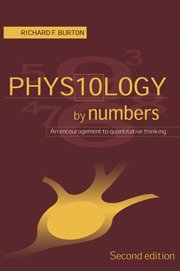Book contents
- Frontmatter
- Contents
- Preface to the second edition
- Preface to the first edition
- How to use this book
- 1 Introduction to physiological calculation: approximation and units
- 2 Quantifying the body: interrelationships amongst ‘representative’ or ‘textbook’ quantities
- 3 Energy and metabolism
- 4 The cardiovascular system
- 5 Respiration
- 6 Renal function
- 7 Body fluids
- 8 Acid–base balance
- 9 Nerve and muscle
- Appendix A Some useful quantities
- Appendix B Exponents and logarithms
- References
- Notes and Answers
- Index
1 - Introduction to physiological calculation: approximation and units
Published online by Cambridge University Press: 06 July 2010
- Frontmatter
- Contents
- Preface to the second edition
- Preface to the first edition
- How to use this book
- 1 Introduction to physiological calculation: approximation and units
- 2 Quantifying the body: interrelationships amongst ‘representative’ or ‘textbook’ quantities
- 3 Energy and metabolism
- 4 The cardiovascular system
- 5 Respiration
- 6 Renal function
- 7 Body fluids
- 8 Acid–base balance
- 9 Nerve and muscle
- Appendix A Some useful quantities
- Appendix B Exponents and logarithms
- References
- Notes and Answers
- Index
Summary
One purpose of the many calculations in later chapters is to demonstrate, as ‘an encouragement to quantitative thinking’, that a little simple arithmetic can sometimes give useful insights into physiology. Encouragement in this chapter takes the form of suggestions for minimizing some of the common impediments to calculation. I have mainly in mind the kinds of arithmetical problem that can suggest themselves outside the contexts of pre-planned teaching or data analysis. Some of the ideas are elementary, but they are not all as well known as they should be. Much of the arithmetic in this book has deliberately been made easy enough to do in the head (and the calculations and answers are given at the back of the book anyway). However, it is useful to be able to cut corners in arithmetic when a calculator is not to hand and guidance is first given on how and when to do this. Much of this chapter is about physical units, for these have to be understood, and casual calculation is too easily frustrated when conversion factors are not immediately to hand. It is also true that proper attention to units may sometimes propel one's arithmetical thinking to its correct conclusion. Furthermore, analysis in terms of units can also help in the process of understanding the formulae and equations of physiology, and the need to illustrate this provides a pretext for introducing some of these.
- Type
- Chapter
- Information
- Physiology by NumbersAn Encouragement to Quantitative Thinking, pp. 1 - 17Publisher: Cambridge University PressPrint publication year: 2000



